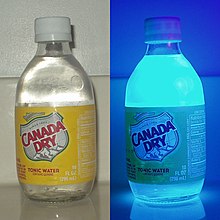Tonic water: Difference between revisions
m Undid probable test edit by 67.169.241.126 (talk) |
No edit summary |
||
| Line 7: | Line 7: | ||
Tonic water originally contained only [[carbonated water]] and a large amount of quinine. However, most tonic water today contains a medically insignificant amount of quinine, and is thus used for its flavor only. It is consequently less bitter, and is also usually sweetened. Some manufacturers also produce diet tonic water. In the [[United States]], the [[Food and Drug Administration]] limits the quinine content in tonic water to 83 [[Parts-per notation#Examples of parts per notation|ppm]] (83 mg per liter if calculated by mass), which 0.25% to 0.50% of the concentration used in therapeutic tonic. |
Tonic water originally contained only [[carbonated water]] and a large amount of quinine. However, most tonic water today contains a medically insignificant amount of quinine, and is thus used for its flavor only. It is consequently less bitter, and is also usually sweetened. Some manufacturers also produce diet tonic water. In the [[United States]], the [[Food and Drug Administration]] limits the quinine content in tonic water to 83 [[Parts-per notation#Examples of parts per notation|ppm]] (83 mg per liter if calculated by mass), which 0.25% to 0.50% of the concentration used in therapeutic tonic. |
||
Tonic water is often used as a [[drink mixer]] for [[cocktail]]s, especially those made with [[gin]] (for example, a [[gin and tonic]]). Tonic water with [[lemon]] or [[Lime (fruit)|lime]] flavor added is known as [[bitter lemon]] or [[bitter lime]], respectively. Such [[soft drink]]s are more popular in [[Europe]] than in the [[United States]]. Consumption of tonic water prevents mild cramps from occurring<ref name="pmid15902691">{{cite journal |author=Miller TM, Layzer RB |title=Muscle cramps |journal=Muscle Nerve |volume=32 |issue=4 |pages=431–42 |year=2005 |pmid=15902691 |doi=10.1002/mus.20341}}</ref>. |
Tonic water is often used as a [[drink mixer]] for [[cocktail]]s, especially those made with [[gin]] (for example, a [[gin and tonic]]). Tonic water with [[lemon]] or [[Lime (fruit)|lime]] flavor added is known as [[bitter lemon]] or [[bitter lime]], respectively. Such [[soft drink]]s are more popular in [[Europe]] than in the [[United States]]. Consumption of tonic water prevents mild cramps from occurring<ref name="pmid15902691">{{cite journal |author=Miller TM, Layzer RB |title=Muscle cramps |journal=Muscle Nerve |volume=32 |issue=4 |pages=431–42 |year=2005 |pmid=15902691 |doi=10.1002/mus.20341}}</ref> (This reference cited makes no mention of the use of tonic water for relief of muscle cramps. It deals directly with OTC quinine dosage which was banned by the FDA in 1994). |
||
Tonic water will fluoresce under [[black light|ultraviolet light]], due to the presence of quinine. In fact, the sensitivity of quinine to ultraviolet light (UV) is such that it will fluoresce in direct sunlight. |
Tonic water will fluoresce under [[black light|ultraviolet light]], due to the presence of quinine. In fact, the sensitivity of quinine to ultraviolet light (UV) is such that it will fluoresce in direct sunlight. |
||
Revision as of 03:04, 11 April 2008
This article has multiple issues. Please help improve it or discuss these issues on the talk page. (Learn how and when to remove these messages)
No issues specified. Please specify issues, or remove this template. |

Tonic water (or Indian tonic water) is a carbonated soft drink flavored with quinine. However, it is not considered to be soda.
The drink gains its name from the medicinal effects of this bitter flavoring. The quinine was added to the drink as a prophylactic against malaria, since it was originally intended for consumption in tropical areas of South Asia and Africa where that disease is endemic.
Tonic water originally contained only carbonated water and a large amount of quinine. However, most tonic water today contains a medically insignificant amount of quinine, and is thus used for its flavor only. It is consequently less bitter, and is also usually sweetened. Some manufacturers also produce diet tonic water. In the United States, the Food and Drug Administration limits the quinine content in tonic water to 83 ppm (83 mg per liter if calculated by mass), which 0.25% to 0.50% of the concentration used in therapeutic tonic.
Tonic water is often used as a drink mixer for cocktails, especially those made with gin (for example, a gin and tonic). Tonic water with lemon or lime flavor added is known as bitter lemon or bitter lime, respectively. Such soft drinks are more popular in Europe than in the United States. Consumption of tonic water prevents mild cramps from occurring[1] (This reference cited makes no mention of the use of tonic water for relief of muscle cramps. It deals directly with OTC quinine dosage which was banned by the FDA in 1994).
Tonic water will fluoresce under ultraviolet light, due to the presence of quinine. In fact, the sensitivity of quinine to ultraviolet light (UV) is such that it will fluoresce in direct sunlight.
Sprinkling a pinch of salt into a glass of tonic water will make the tonic water lose its bitterness, due to the bitterness-masking nature of salt.
See also
References
- ^ Miller TM, Layzer RB (2005). "Muscle cramps". Muscle Nerve. 32 (4): 431–42. doi:10.1002/mus.20341. PMID 15902691.
